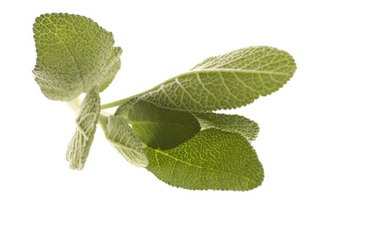
Sage harvested from your herb garden can add a delightful flavor to sausage, meatloaf or stuffing. What's more, you can preserve those slightly bitter-tasting sage leaves to use when winter has covered your garden with a blanket of snow. Drying sage in a food hydrator will get the task done quickly, and the finished product will be three to four times more pungent than fresh sage. When using your food dehydrator, always start with clean, dry trays.
Step 1
Preheat the dehydrator to between 95 and 115 degrees, following the instructions of the dehydrator's manufacturer. If you are in a humid area, turn the machine to 125 degrees.
Video of the Day
Step 2
Cut stems with leaves from the stage plant without bruising the leaves. The ideal time for harvesting is before the flowers open, when they are still buds. Gather the sage in the morning, immediately after any dew has evaporated.
Step 3
Rinse the leaves under cold running water and gently shake them to remove the water.
Step 4
Lay the stems of leaves on the trays of the dehydrator in one layer without overlapping. Remove any leaves or stems that are defected in any way.
Step 5
Cover the food dehydrator according to the instructions of its manufacturer. For a stacking food dehydrator, this involves stacking the trays on the base of the machine and adding a cover, while a drawer-styled dehydrator will require you to insert the trays like a drawer.
Step 6
Leave the machine running and periodically check the drying progress. It can take between one and four hours. If the stems break or the leaves crumble, they are ready to remove from the machine. Remove the leaves from the stems and store the leaves in an airtight container.
Tip
If you don’t have a food dehydrator, air dry the sage by tying it into a bundle and hanging it upside down in a dry, dark, warm area -- preferably indoors -- for several weeks.
Video of the Day